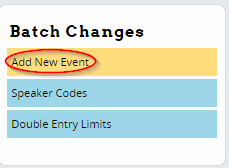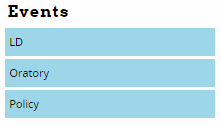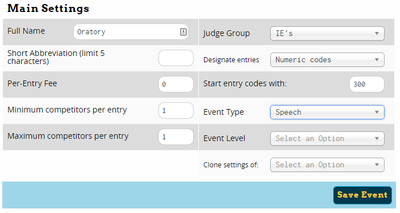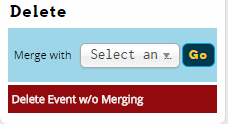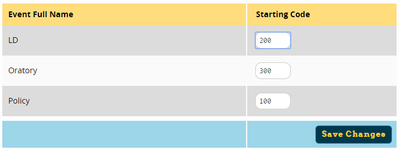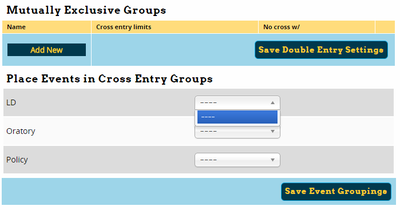Events
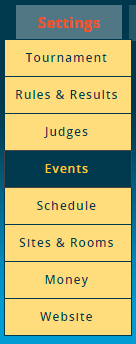
The Events menu option lets you configure which events you will offer at your tournament, as well as a number of options specific to each event. While not required, it's usually recommended that you set up your Judge Groups before configuring your events. This will make it less likely you make a mistake or forget to assign an event to a judge group.
Adding Events
To add an event, click the "Add New Event" link in the sidebar:
Fill out the same information shown on the "Main" tab below, and click "Save Event." Once you have created an event, you will see it listed on the right.
Clicking the name of an event in the sidebar will allow you to edit the settings for that event, and will show you a set of tabs for different settings:
You will also have a link on the sidebar to go directly to the settings for the Judge Group affiliated with that event.
Main Event Settings
The Main tab contains all the general settings for that event:
Full Name - The full name of your event. If setting up multiple divisions of the same event, should include something like "Open" or "Novice in the name as well.
Short abbreviation (limit 5 characters) - Tabroom will use this short abbreviation in many spots in the interface and printed materials. For example, you could use OLD for Open LD and NLD for Novice LD.
Per-Entry Fee - How much a school will be charged for each entry in this event. Note that an "entry" includes however many competitors you set for the event (e.g. 1 for LD, or 2 for CX).
Minimum competitors per entry - The minimum number should almost always be 1 (for IE's and LD), or 2 (for team debate events). You could set it to 1 for a team event if you wanted to allow maverick entries.
Maximum competitors per entry - The maximum number is almost always 1 (for IE's and LD), or 2 (for team debate events). If you have a debate event that allows 3 or 4 person teams (for example novice policy in some states), you would use a higher number. Note that this is NOT a per-school cap on the number of entries you can have in an event, it is only the limit on the number of people in a single entry.
Judge Group - Which judge group the event should pull judges from. If you use similar names for your event and judge group, you may find this set to the correct value automatically. If you created your events before creating a judge pool, make sure to return to this screen and set a judge group once you have configured them.
Designate entries - Controls how entries will appear in registration lists and on schematics and ballots. You have a large number of choices to use various combinations of numeric codes, first/last names, initials, or school codes or names. Note that changing this setting does not affect entries which have already been created/entered. So you if you change this half-way through your registration window, you may need to go to Entries -> Data and "recode" your entries to get a consistent scheme. For more information, see the section on Managing Entries.
Start entry codes with - Numeric value to start the entry codes with for the event, so that for example all LD entries start with 200, Oratory starts with 300, etc. You can also assign these values en masse for all events. See the section below on #Speaker Codes.
Event Type - Set the type of event, for example Speech, Congress, Policy, LD, PF, or "Debate" for other forms of debate. This will help Tabroom format certain things correctly or provide reasonable defaults geared toward the event in question.
Event Level - Choose between Open/Varsity, JV, Novice, etc. This will affect how certain result sets are computed, for example if you wanted to get a list of the best Novice participants across all events.
Clone settings of - If you choose another event and click "Save Event," it will overwrite your current Event settings with the settings from the other event. This is useful when creating a large number of similar events, for example Open and Novice divisions for each of a number of IE's.
Deleting/Merging Events
If you need to delete an event, first select it from the list on the sidebar, and then use the "Delete" box:
If you want to merge or "collapse" the event into another, for example if the Novice division was too small and had to be merged with the Open division, select the event in the "Merge with" box and click Go.
Or, you can just delete the event by clicking the "Delete Event w/o Merging" button instead.
Speaker Codes
If you need to manually change the starting code number for multiple events, it's usually faster to do this all at once than edit each individual event's settings. Click the "Speaker Codes" link under Batch Changes in the sidebar, and you will be given a list of all events and their starting codes. Just edit the codes in one place, and then click "Save Changes:"
Double Entry Limits
At many tournaments, students are allowed to "double enter" in multiple events, for example Oratory and DI, or in multiple events that take place during different time blocks, for example 1 debate event and 1 IE. At other tournaments, all double entries are disallowed, or restrictions are placed on how many/which events are available to double enter.
By default, double entries are not allowed. To enable them or configure which events can be double entered, select the "Double Entry Limits" option on the sidebar.
First, you'll need to enable double entries by changing the Tournament-wide setting.
You can choose to "Allow up to maximum" to choose the maximum number of competitors that will be allowed to double enter at the tournament, or choose "Unlimited double entry" to set no limit.
If desired, you can then configure "groups" of events which are mutually exclusive with other groups, for example if you can enter only one of LD or Policy:
To create a group, click "Add New" and then give the group a name and choose what kinds of double entries (if any) are allowed:
If you choose "None" then entries within that group will not be allowed to enter any other events. If you choose "Unlimited" then they will be able to enter any other events. If you choose "None within group" then they will only be able to enter one event within that group (e.g. only one of Policy or LD). Or, you can set a maximum number of events that can be entered in the group.
Once you have set up the group, you can add events to it by choosing the group for each event, and clicking "Save Event Groupings." If you have multiple groups, you can also choose a value for any mutually exclusive "Cross Entry Group."
